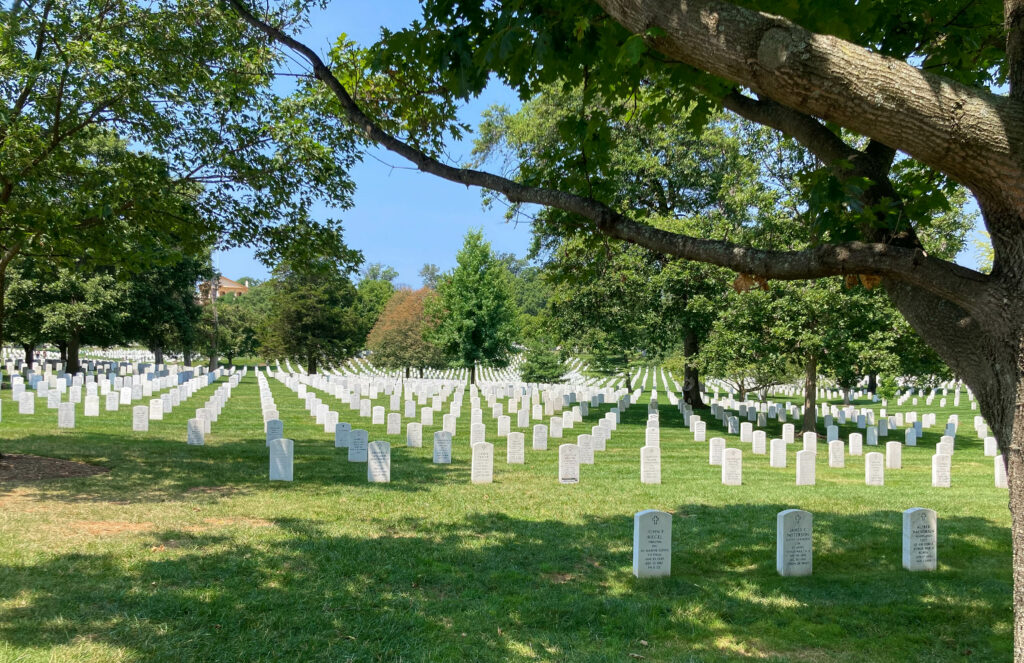Arlington National Cemetery in Virginia is the final resting place for more than 400,000 American service members and their families. About 8,500 trees from 300 different species rise above the rolling green hills and sparkling white headstones that cover its more than 639 acres.
More than 4 million people pay respects at the Cemetery each year. I have visited several times over the years, and recently spent a sunny day with some family members from out of state.
Among the most popular sites are:
Arlington House
Arlington National Cemetery was established in 1864, on land seized by the Union government from Mary Custis Lee, great-granddaughter of Martha Washington and wife of Robert E. Lee.
Her father, George Washington Parke Custis, had owned the land and built its mansion early in the 19th century. The columned house sits high on a hilltop overlooking Washington, D.C. When he died in 1857, his daughter inherited the property.
Four years later, the Civil War broke out. Union troops occupied the property on May 24, 1861, and turned it into a headquarters. As the Yankee dead began to exceed the space available in local cemeteries, the Union Army started to bury them at Arlington.
The U.S. Supreme Court ruled in 1882 that the federal government had illegally seized the land. But rather than force the government to dig up the dead, Custis Lee, Mary and Robert’s son, sold the property for $150,000.
Tomb of the Unknown Soldier
The most moving site at Arlington National Cemetery is the Tomb of the Unknown Soldier. Buried there are unidentified soldiers from World War I, World War II, and the Korean War. A white marble sarcophagus sits atop the vaults facing Washington, D.C. It features three Greek allegorical figures representing Peace, Victory, and Valor.
Twenty-four hours a day, every day, no matter the weather, Sentinels from the 3rd U.S. Infantry Regiment of the Army, known as “The Old Guard”, stand watch over the Tomb.
The elaborate and precise Changing of the Guard ceremony takes place every half-hour during daylight in April-September, every hour during daylight in October-March, and every two hours at night. A relief commander conducts a thorough inspection of the arriving Guard’s M-14 rifle. Then, the relief commander and the arriving Guard meet the retiring Sentinel at the center of the black mat in front of the Tomb. The three living soldiers salute the three Unknowns. Orders are passed on, and the newly posted Guard steps into position on the mat. All three walk in cadence until the relief commander and retiring Sentinel continue back to their quarters.
The Tomb Guard marches exactly 21 steps down the black mat behind the Tomb, turns and faces east for 21 seconds, turns and faces north for 21 seconds, takes 21 steps down the mat, and repeats the process. The 21 steps and seconds symbolize a 21-gun salute, the highest military honor. When turning, the Sentinel places his rifle on the shoulder closest to the visitors, showing that he stands between the Unknowns and any possible threat. He will also loudly admonish any misbehaving visitors to conduct themselves with silence and respect.
John F. Kennedy Eternal Flame
On Veterans Day, November 11, 1963, President John F. Kennedy placed a wreath at the Tomb of the Unknown Soldier. Two weeks later, on November 25, he was buried at Arlington National Cemetery, after being assassinated in Dallas, Texas. The original grave sat on a sloping hillside. Because of large crowds of visitors, the gravesite was moved to its present location in 1967. The late President’s widow, Jacqueline Bouvier Kennedy, lit an eternal flame, which burns from the center of a five-foot circular granite stone at the head of the grave. She was buried there on May 23, 1994, following her death on May 19. Buried alongside them are their son Patrick, who lived two days in August 1963, and their daughter who was stillborn in August 1956.
Other monuments and memorials include the Space Shuttle Challenger Memorial which honors the crew of STS-51-L who died on January 28, 1986, shortly after lift-off. A similar memorial honors the crew of STS-107 who perished when the shuttle Columbia was destroyed during re-entry on February 1, 2003. Others honor those who died in the terrorist attacks on Pan Am Flight 103 over Lockerbie, Scotland, December 21, 1988, and on the Pentagon on September 11, 2001.
This post contains affiliate links. For more information, click here.
What to Know Before You Go to
Arlington National Cemetery
Arlington National Cemetery is located just across the Potomac River from Washington, D.C, in Arlington, Virginia. The main entrance is at the end of Memorial Avenue, which extends from Memorial Bridge. There is a paid parking garage. There is also an Arlington Cemetery stop on the Metro’s blue line.
Arlington National Cemetery is free of charge to explore. There is a Welcome Center with exhibits that teach the story and significance of the Cemetery. There is also a bookstore and an information desk, where you can pick up maps and brochures and ask questions.
The Web site states that all visitors 16 years of age and older must present identification, but no one in my family was asked to do so on our recent visit. We did have to go through a standard security screening.
The grounds are beautiful and somber. They are also walkable, but they are hilly and expansive. If you prefer, you may take a narrated tram tour that includes the three major sites described in this post.
Wear comfortable but respectful clothing and shoes. Bring bottled water, especially in hot weather. Allow two to three hours.
After my misspent youth as a wage worker, I’m having so much more fun as a blogger, helping other discerning travellers plan fun and fascinating journeys. Read more …

